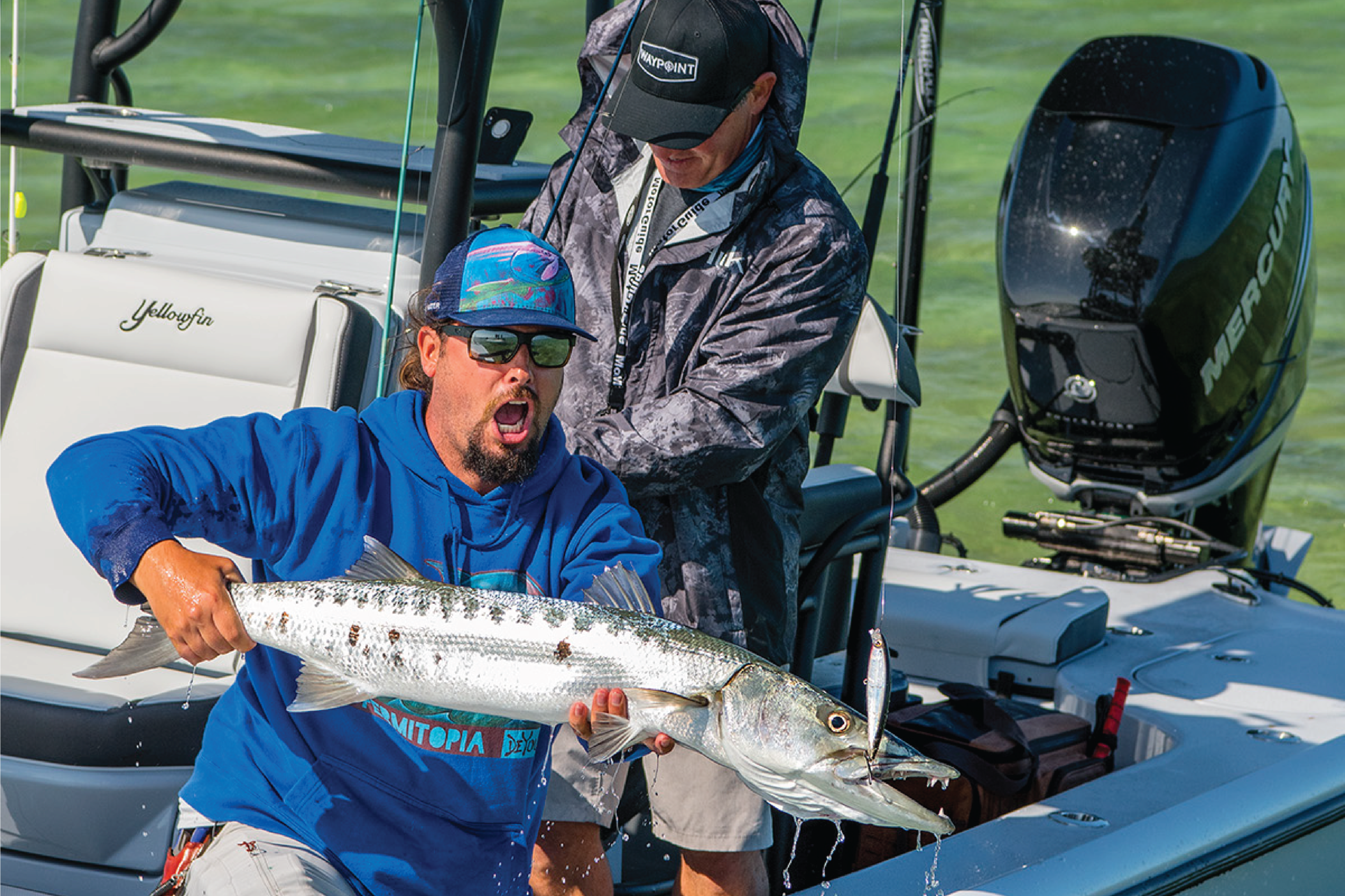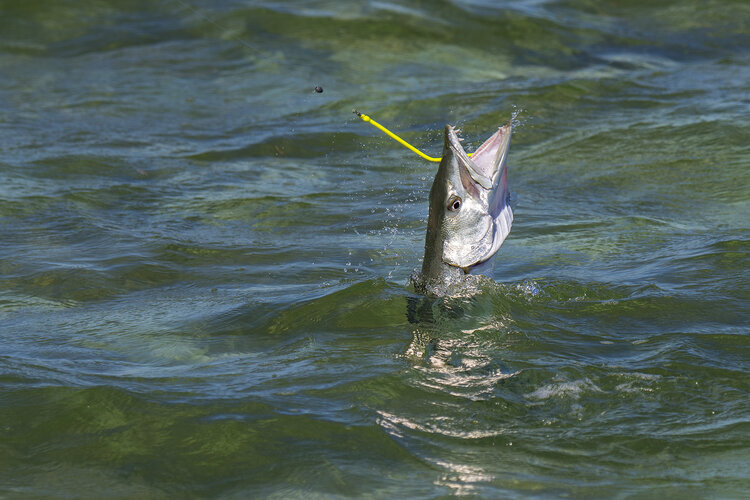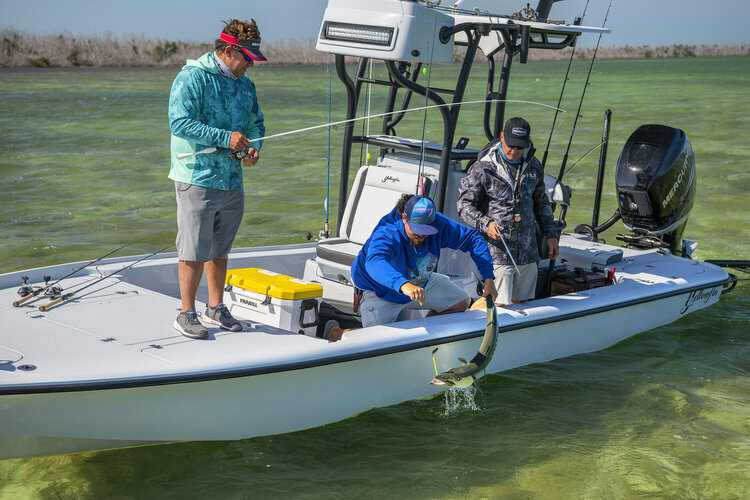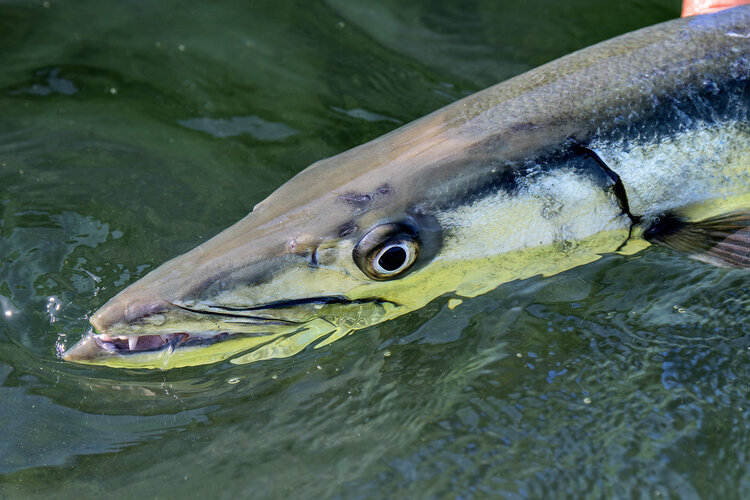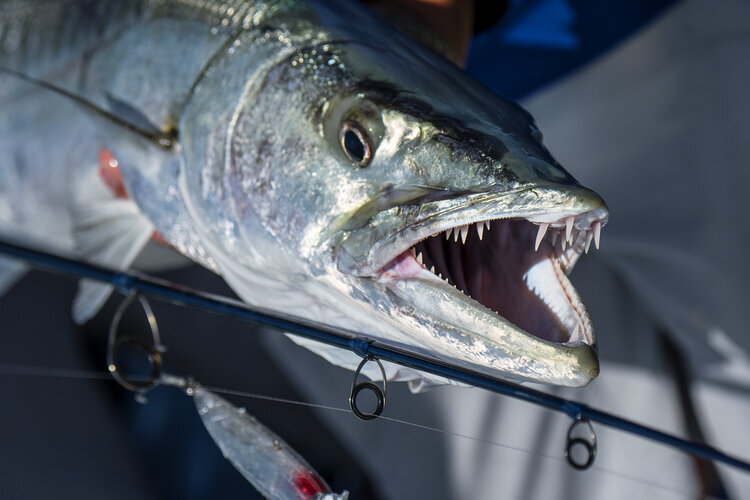2 Quick Tips For Catching Cudas with Derek DeYoung and Saltwater Experience
written by Evan Anderson
Barracuda have an unfair reputation among many saltwater anglers as a pest, but they can actually be a lot of fun to fish for in and of themselves, as we’ll see here in this episode of Saltwater Experience. Captains Tom Rowland and Rich Tudor make their way down to Big Pine, FL to meet up with acclaimed artist Derek DeYoung, an avid fisherman drawn particularly toward barracuda. “If this existed in freshwater,” says DeYoung, “It would be the coolest thing I’ve ever done in freshwater.” Comparing it to musky fishing, DeYoung says that barracuda are “way more fun. There’s way more of these, they’re huge, and they’re more aggressive.” We’ll get into some of the tactics used by the experts here as well as how DeYoung brings his experience as an angler into his art. Here are 2 quick tips for barracuda fishing.
SE Multimedia | 2020
WHERE TO FIND THEM
As the three fishermen launch their Yellowfin from Rowland’s Ameratrail boat trailer secured by the trusted B&W Trailer Hitch, a few passersby call out DeYoung’s name. “Big Pine’s a cool place,” remarks Rowland, “There’s just a different feel back there. Everybody’s laid back and cool, just like Derek.”
From there the crew sets out to DeYoung’s frequent barracuda havens. “We go to an area that barracudas tend to like; it’s kind of a lighter hard bottom with turtle grass on the outskirts,” Rowland explains, “We were able to hide behind the shoreline, we were able to go along an area that had an extended white bottom, and sure enough, they were in there.” Rowland also mentions that barracudas tend to get in the lee of some structure, the side of an object or shoreline sheltered from the wind, “and this first spot that he took us to had that.”
“There’s way more [barracuda than muskies], they’re huge, and they’re more aggressive.”
Tudor, standing on the tower of the boat, was able to get a great perspective of the area. “Where the fish were stacked up the most,” he says, “was right on that shallow edge, very similar to where we find bonefish...where we went from about 8 inches of water and dropped down to about 2 feet, that seemed to be the zone where most of those cudas were sitting.”
After Rowland makes a remark on the water temperature, DeYoung replies “These Keys-cold winter days shut down a lot of the other fisheries and we can come and do this.”
2. LIGHT TACKLE, BIG FIGHT
DeYoung impressed Rowland and Tudor. “He was like a musky fisherman,” says Tudor, “he had all these different plugs and all these different ones that he likes. He had some that would float, but once you pulled them they twitched right onto the surface of the water.”
A lot of DeYoung’s skill is rooted in his Midwest origins. “Derek’s from Michigan,” observes Tudor, “and I think he’s spent a lot of time with the pikes and the muskies, things like that, and you can see some of those same casting techniques and mentality. You could tell he was at home covering water.”
Rowland and DeYoung both set their lures up similarly, using baits that come out of the package with two treble hooks and a diving lip, Rowland customized his by breaking off the lip and removing the front hook, leaving only the second hook in the back. DeYoung also removed the lead treble hook on his swimming plug. They then would add a 1 foot shot of no. 4 40-lb wire, a 30-lb fluorocarbon leader, and use 10 to 15 lb braided line on a size 3000 Daiwa reel. “You could throw those things a mile,” says Tudor. Rowland comments that he loves this setup because of how light it is. “It’s like a bonefish rod,” he says.
Another aspect of cuda fishing is the fast pace. “You’re doing something the whole time,” says Rowland, “there’s no down time. You’re either casting as far as you can or you’re reeling as fast as you can or you’re setting the hook or fighting a fish.” Fast reeling is important for barracuda because they are an aggressive predator, and you want to trigger that instinct with bait that is fast and animated. You also want to use a long dehooking device such as Rowland uses because of their sharp teeth.
“There’s no down time. You’re either casting as far as you can or you’re reeling as fast as you can or you’re setting the hook or fighting a fish.”
Loading the boat back onto his Ameratrail Trailer after a great day on the water, Rowland takes another look around at the art scattered all over DeYoung’s house in Big Pine. Both Rowland and Tudor were especially moved by how strong the connection was between DeYoung’s art and his love of these incredible fish. Every time they pulled a cuda into the boat DeYoung was right there examining every little detail, pointing out small differences and imperfections that make each one unique. “In nature, seldom is everything perfect,” comments DeYoung. Rowland was deeply impressed, saying “You could see he was making mental pictures thinking, “How could I mix some paint to look just like that?””
“In nature, seldom is everything perfect.”
SE Multimedia | 2020
Rowland and Tudor said goodbye to DeYoung and headed back up the road to Hawks Cay Resort. The Florida Keys are 150 miles long and these guys safely tow all of their boats up and down the Keys with the help of B&W Trailer Hitches. B&W offers a Tow and Stow model that solves the problem of using multiple boats and trailers with different size hitch balls. Rowland uses a Black Tow & Stow Hitch (5" drop x 5 1/2" rise) Dual Ball (2" x 2-5/16") for 2" Receiver - B&W TS10037B that allows him to switch trailers easily and also make sure that the trailer is towing level and smooth.
If you want to see some of DeYoung’s art for yourself, check out his website at www.derekdeyoung.com. You can also find him on Instagram: @derek.deyoung. And if you want to see the artist in action, check out the full episode below! This is Part 1 of a 2-part special with DeYoung, so be on the lookout for part 2 coming soon to WAYPOINT.
Additionally, Derek DeYoung has been a guest on The Tom Rowland Podcast. You can listen to this episode by clicking here or the player below.
You can find plenty of Saltwater Experience content on Instagram at @saltwater_experience, @tom_rowland, and @rich_tudor1. We also post lots of clips from the show on our pages @waypointfish, @waypointsalt, @waypointboating, and @waypointtv.


